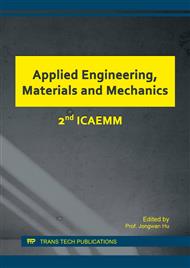[1]
API Standard 617, Seventh Edition. Axial and Centrifugal Compressor and Expander-Compressor for Petroleum, Chemical and Gas Industry Services. American Petroleum Institute, Washington D.C. (2002).
Google Scholar
[2]
H. Benchert, J. Wachter, 'Flow Induced Spring Coefficients of Labyrinth Seals for Application in Rotordynamics, NASA CP2133, Proceedings of the workshop: Rotordynamic Instability Problems in High Performance Turbomachinery, held at Texas A&M University, 12–14 May 1980, (1980).
Google Scholar
[3]
H. R. Wyssmann, T. C. Pham, R. J. Jenny, Prediction of stiffness and damping coefficients for centrifugal compressor labyrinth seals. ASME J. Eng. Gas Turbines Power, 106 (1984) 920-926.
DOI: 10.1115/1.3239659
Google Scholar
[4]
K. K. Nielsen, Rotordynamic Impact of Swirl Brakes, Diploma Course Report 1997-28, von Karman Institute for Fluid Dynamics, Rhode-St-Gene`se, Belgium, (1997).
Google Scholar
[5]
K. K. Nielsen, R. A. Van den Braembussche, C. M. Myllerup, Optimization of Swirl Brakes by Means of a 3D Navier-Stokes Solver, ASME Paper No. 98-GT-328, (1998).
DOI: 10.1115/98-gt-328
Google Scholar
[6]
K. K. Nielsen, C. M. Myllerup, R. A. Van den Braembussche, Parametric Study of the Flow in Swirl Brakes by Means of a 3D Navier-Stokes Solver, C557/088/99/, Transactions of the Third European Conference on Turbomachinery, (1999), pp.489-498.
DOI: 10.1115/98-gt-328
Google Scholar
[7]
E. A. Baskharone, Swirl Brake Effect on the Rotordynamic Stability of a Shrouded Impeller, ASME J. Turbomach. 121 (1999) 127-133.
DOI: 10.1115/1.2841221
Google Scholar
[8]
U. Baumann, Rotordynamic stability tests on high-pressure radial compressors. Proceedings of the 28th turbomachinery symposium, (1999), pp: 115-122.
Google Scholar
[9]
J. Schmied, M. Spirig, N. Wagner, P. Critchley: Influence of Seals with Frequency Dependent Characteristics on the Rotordynamic Behavior of High Pressure Compressors. Fluid-Struktur-Wechselwirkung, VDI-Berichte 1682, Tagung in Wiesloch bei Heidelberg, Deutschland, (2002).
Google Scholar
[10]
N. Xi, et al., Dynamic performance analysis of seals in a centrifugal compressor and rotor stability evaluation, J. Vib. Shock. 13 (2013) 153-158.
Google Scholar
[11]
Z. L. Sun, Stability analysis of rotor dynamic system for centrifugal compressors. Compr. Blow. Fan Tech. 2 (2013) 24-27.
Google Scholar
[12]
Y. J. Zhu, Study on the stability evaluation and instability fault diagnosis of the centrifugal compressor. Beijing University of Chemical Technology, (2012).
Google Scholar


